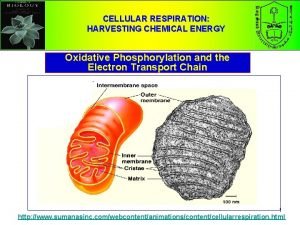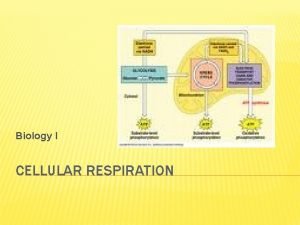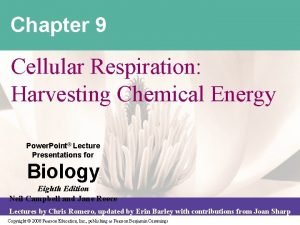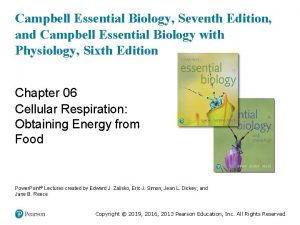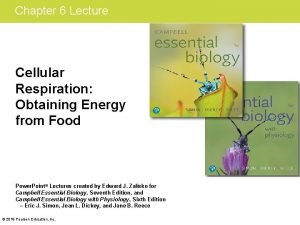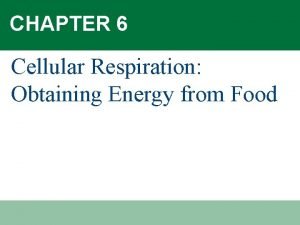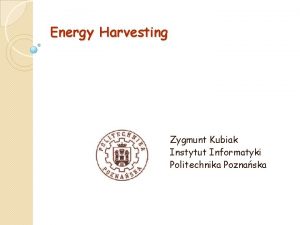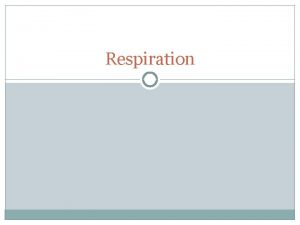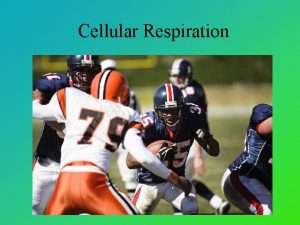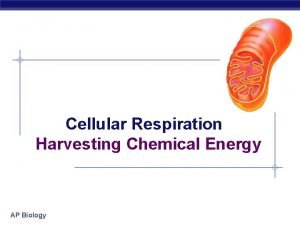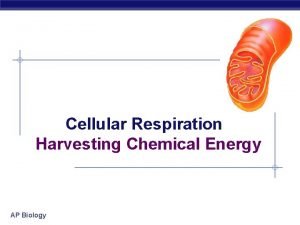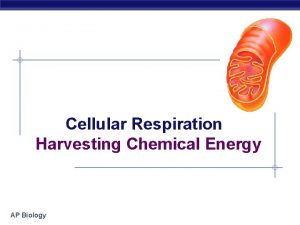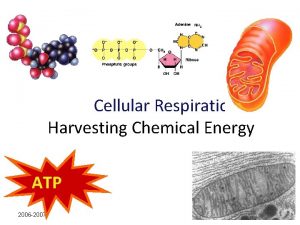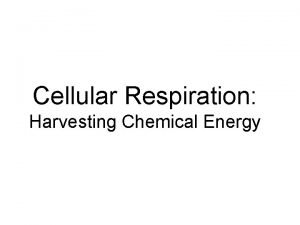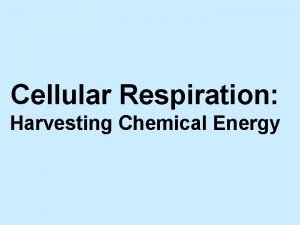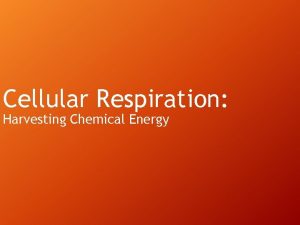Cellular Respiration Harvesting Chemical Energy 2006 2007 Cellular



















- Slides: 19

Cellular Respiration Harvesting Chemical Energy 2006 -2007

Cellular Respiration Stage 1: Glycolysis Today I will… 1. Describe the process of glycolysis. 2. State the reactants and products of glycolysis. Modified from Kim Foglia

What’s the point? ATP The Point is to Make ATP! 2006 -2007

Glycolysis � Breaking down glucose ◦ “glyco – lysis” (splitting sugar) glucose pyruvate 2 x 3 C 6 C ◦ most ancient form of energy capture �starting point for all cellular respiration ◦ inefficient �generate only 2 ATP for every 1 glucose ◦ occurs in cytosol �why does that make evolutionary sense?

Evolutionary perspective � Life on Earth first evolved without free oxygen (O 2) in atmosphere ◦ energy had to be captured from organic molecules in absence of O 2 � Prokaryotes that evolved glycolysis are ancestors of all modern life ◦ ALL organisms still utilize glycolysis

Overview 10 reactions ◦ convert 6 C glucose to two 3 C pyruvate ◦ produce 2 ATP & 2 NADH glucose C-C-C-C 2 ATP 2 ADP ac t en ivat erg ion y fructose-6 P P-C-C-C-P DHAP P-C-C-C 2 Pi G 3 P = glyceraldehyde-3 -phosphate DHAP = dihydroxyacetone phosphate G 3 P (PGAL) C-C-C-P 2 NAD+ pyruvate C-C-C 2 NADH 4 ADP 4 ATP

Glycolysis summary endergonic invest some ATP exergonic harvest a little ATP & a little NADH yield 2 ATP 2 NADH

1 st half of glycolysis (5 reactions) �Glucose “priming” ◦ get glucose ready to split �phosphorylate glucose �rearrangement ◦ split destabilized glucose PGAL

2 nd half of glycolysis (5 reactions) � Energy Harvest ◦ NADH production �G 3 P donates H �oxidize sugar �reduce NAD+ �NAD+ NADH ◦ ATP production �G 3 P pyruvate �sugars donate P �ADP ATP

Energy accounting of glycolysis 2 ATP 2 ADP glucose pyruvate 2 x 3 C 6 C 4 ADP � Net 4 ATP gain = 2 ATP ◦ some energy investment (-2 ATP) ◦ small energy return (+4 ATP) � 1 6 C sugar 2 3 C sugars

Is that all there is? � Not a lot of energy… ◦ for 1 billon years+ this is how life on Earth survived… Why? �slow growth, slow reproduction �only harvest 3. 5% of energy stored in glucose �more carbons to strip off = more energy to harvest O 2 O 2 O 2 glucose pyruvate 2 x 3 C 6 C

We can’t stop there…. glucose + 2 ADP + 2 Pi + 2 NAD+ Glycolysis 2 pyruvate + 2 ATP + 2 NADH glucose + 2 ADP + 2 Pi + 2 NAD+ 2 pyruvate + 2 ATP + 2 NADH � Going to run out of NAD+ ◦ without regenerating NAD+, energy production would stop ◦ another molecule must accept H from NADH How is NADH recycled to NAD+? NADH

How is NADH recycled to NAD+? � Another molecule must accept H from NADH ◦ aerobic respiration O 2 �to Electron Transport Chain in mitochondria ◦ anaerobic respiration �ethanol fermentation �lactic acid fermentation NADH which path you use depends on who you are… O 2

Fermentation (anaerobic) � Bacteria, yeast pyruvate ethanol + CO 2 3 C NADH § beer, wine, bread 2 C NAD+ to glycolysis § Animals, some fungi pyruvate lactic acid 3 C NADH 3 C NAD+to glycolysis § cheese, anaerobic exercise (no O 2) 1 C

Alcohol Fermentation pyruvate ethanol + CO 2 3 C NADH 2 C NAD+ § Dead end process § at ~12% ethanol, kills yeast § can’t reverse the reaction 1 C bacteria yeast

Lactic Acid Fermentation pyruvate lactic acid NADH 3 C NAD+ 3 C § Reversible process § once O 2 is available, lactate is converted to pyruvate by liver O 2 animals

Pyruvate is a branching point Pyruvate O 2 fermentation Kreb’s cycle mitochondria

What’s the point? ATP The Point is to Make ATP! 2006 -2007

And how do we do that? H+ H+ � Set up a H+ gradient � Allow the H+ to flow through ATP synthase ADP + Pi ATP ADP + Pi ATP Have we done that yet? H+ H+
 The stages of cellular respiration
The stages of cellular respiration Chapter 9 cellular respiration harvesting chemical energy
Chapter 9 cellular respiration harvesting chemical energy Chapter 9: cellular respiration: harvesting chemical energy
Chapter 9: cellular respiration: harvesting chemical energy Phosphorelation
Phosphorelation What's the equation for cellular respiration
What's the equation for cellular respiration Word equation for photosynthesis
Word equation for photosynthesis What is the word equation for cellular respiration
What is the word equation for cellular respiration Inputs of glycolysis
Inputs of glycolysis Energy flow in cellular respiration
Energy flow in cellular respiration Cellular respiration obtaining energy from food
Cellular respiration obtaining energy from food Cellular respiration obtaining energy from food
Cellular respiration obtaining energy from food Internal respiration vs external respiration
Internal respiration vs external respiration Internal external respiration
Internal external respiration Poznaska
Poznaska Cellular energy section 1 how organisms obtain energy
Cellular energy section 1 how organisms obtain energy Cellular respiration redox
Cellular respiration redox What is the correct equation for cellular respiration?
What is the correct equation for cellular respiration? Cellular respiration steps
Cellular respiration steps Cellular respiration product
Cellular respiration product Was ist fermentiert
Was ist fermentiert



